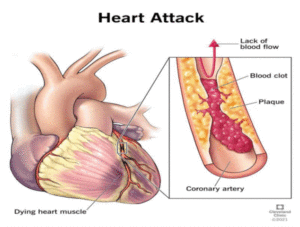FACTS ABOUT EXERCISE AND HEART HEALTH
1) How much exercise is too much exercise? The amount of exercise that is considered “too much” varies from person to person and depends on several factors, including individual fitness levels, goals, age and overall health. What may be too much for one person could be insufficient for another. It is essential to strike a balance between physical activity and recovery. Overtraining can have negative consequences on your physical and mental health.

For example: Siddharth Shukla, an Indian TV actor and a fitness freak, was passed away because of a heart attack. A couple of weeks later, the news flashed the death of an actor and comedian Raju Srivastava suffering a heart attack while working out in a gym. A few months earlier, KK, an Indian singer, was in the headlines for the same. They followed the exercise routine. However, knowing that they passed away due to a heart attack despite proper diet and adequate exercise made me wonder if exercise actually helped improve cardiovascular health? I was perturbed as to how the workout culture that was supposed to improve health and longevity of life was in all reality shortening it.
2) How does the heart function? Heart is nothing but a bundle of muscles. The more you exercise, the stronger it becomes. However, unlike any other muscle, it needs a recovery period to avoid overstraining. Apart from this, the cardiovascular system comprises not only the heart, but also the blood vessels like the Aorta and Coronary arteries. Several natural factors like ageing, poor diet and lack of exercise lead to deposition of collagen fibres and fat in the form of plaque in the lumen of these arteries and narrowing of these arteries, which gradually leads to increase in blood pressure. The increased blood pressure and dyslipidaemia later become a risk factor for coronary heart disease, myocardial infarction, etc. However, a healthy, nutritional diet along with a regular exercise regimen with adequate cardiovascular exercises and strength training has proved to maintain a healthy heart (Bergheanu et al., 2017).

3) What is wrong with the current fitness trend? Increasing awareness about cardiovascular health over the last two decades has pushed people to gyms and fitness Centres. As the number of incidences of cardiac arrest shoots up in the country, more and more people rush to gyms to maintain their cardiac health, without consulting the doctors and physicians about their capacity to workout. Moreover, the booming fitness industry recruited incompetent trainers who focused more on the strength training and muscle-building part of exercise, completely ignoring the part about cardiovascular health. Considering the problem from a multifaceted view, the fashion industry and the newly emerged ‘social media influencer’ culture led to the promotion of a healthy body image as a ‘six pack’ or lean, thin body. Not only the people start working out, but they also start working out intensely to fit into the societal image of a healthy body without considering the consequences of the intense workout routine. Also, the intensity of the workout varies indirectly with the time period in which the crisp body image needs to be achieved. It means a woman looking to get into shape for a wedding in one month will work out more intensely than the one who has to attend an event 3 months later.

4) How does it affect cardiovascular health? Research proves that excess physical activity without adequate recovery period can also lead to increased risk of heart attack. Extremely strenuous workout routine with high intensity makes an individual more prone to acute cardiac events. Especially with those having a genetic predisposition to cardiac diseases or having an undiagnosed underlying condition, sudden intense workout can prove to be fatal. According to a study, extremely intense exercises increase the demand on the heart muscles and makes the individual more prone to Sudden Cardiac Arrest (SCA) or Sudden Cardiac death (SCD). It occurs because of hypertrophy of muscles and thicker heart walls to meet the increased demand of body that leads to scarring of heart (Thompson et al., 2007).
5) What can keep your heart healthy? Having said that, it can be safely concluded that some exercise is better than no exercise. Experts recommend a minimum of 150 minutes of exercise per week with inclusion of both moderate aerobic exercise and light strength training (Chambliss, 2005). This does not mean aspiring bodybuilders or runners should not exercise beyond the safe limit. However, getting screened for any underlying cardiac issues will help determine how much exercise is too much exercise for them. Also, without any exception, a healthy diet should always go hand-in-hand with exercise. Fixing a time stamp to the desired weight or inch loss might not always be helping you and instead causing you to lose the potential benefits of exercise. So, the next time any person in the gym tells you that they need to lose weight for their birthday, tell them to let go of the time stamp and enjoy exercising as it is. Lastly, however good your exercise and diet regimen are, stress is a factor that will get at your cardiovascular health now or then. So instead of stressing it out, work it out, but build it up gradually and progressively at a slower pace.
References:
Bergheanu SC, Bodde MC, Jukema JW. Pathophysiology and treatment of atherosclerosis. Netherlands Heart Journal 2017;25(4):231-242. https://doi.org/10.1007/s12471-017-0959-2.
Thompson PD, Franklin BA, Balady GJ, Blair SN, Corrado D, Estes NM, Fulton JE, Gordon NF, Haskell WL, Link MS, Maron BJ, Mittleman MA, Pelliccia A, Wenger NK, Willich SN, Costa F. Exercise and acute cardiovascular events. Circulation. 2007; 115(17): 2358-2368. https://doi.org/10.1161/circulationaha.107.181485
Chambliss HO. Exercise duration and intensity in a weight-loss program. Clinical Journal of Sport Medicine 2005; 15(2): 113-115. https://doi.org/10.1097/01.jsm.0000151867.60437.5d